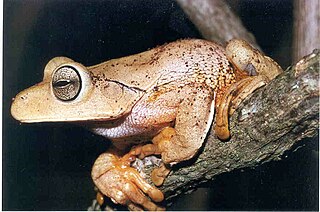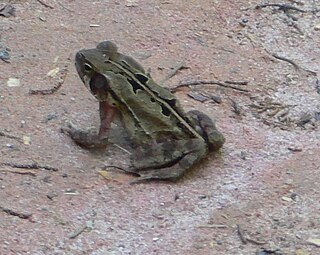 W
WThe blacksmith tree frog, or smith frog, is a frog species in the family Hylidae. It is found in north-eastern Argentina, south-eastern Paraguay, and eastern to southern Brazil. Its natural habitats are tropical humid forests, including forest edges, at elevations of 150–800 m (490–2,620 ft) above sea level. Breeding takes place in temporary and permanent pools and slow-moving streams where the frogs make nests.
 W
WBothrops bilineatus, also known as the two-striped forest-pitviper, parrotsnake, Amazonian palm viper, or green jararaca, is a highly venomous species of pit viper found in the Amazon region of South America. Two subspecies are currently recognized, including the nominate subspecies described here. A pale green arboreal species that may reach 1 m (3.3 ft) in length, it is an important cause of snakebite throughout the entire Amazon region.
 W
WDesmodus is a genus of bats which—along with the genera Diaemus and Diphylla—are allied as the subfamily Desmodontinae, the carnivorous, blood-consuming vampire bats of the New World leaf-nosed bat family Phyllostomidae.
 W
WDiclidurus is a genus of bats whose common name is the ghost bats. Diclidurus all inhabit tropical South America, and D. albus is also found in Mexico and Central America. The fur of these insectivorous bats is white, sometimes with a slight greyish tinge, except D. isabella, which is partially pale brown. The only other all-white bat in the New World is the Honduran white bat, but it is easily distinguished from Diclidurus by its relatively large nose leaf. Diclidurus are poorly known and only infrequently captured, at least in part because they fly high above the ground or in the forest canopy.
 W
WThe pinyon jay is a jay between the North American blue jay and the Eurasian jay in size. The voice is described as a rhythmic krawk-kraw-krawk repeated two or three times. It is the only member of the genus Gymnorhinus. Its overall proportions are very nutcracker-like and indeed this can be seen as convergent evolution as both birds fill similar ecological niches. The pinyon jay is a bluish-grey coloured bird with deeper head colouring and whitish throat with black bill, legs and feet.
 W
WThe northern ghost bat is a bat species from South America, Trinidad, and Central America. It is a relatively rare, completely white, insectivorous bat, with an unusual sac at the base of its tail.
 W
WPerognathus is a genus of pocket mouse. Like other members of their family they are more closely related to pocket gophers than to true mice.
 W
WThe pinyon jay is a jay between the North American blue jay and the Eurasian jay in size. The voice is described as a rhythmic krawk-kraw-krawk repeated two or three times. It is the only member of the genus Gymnorhinus. Its overall proportions are very nutcracker-like and indeed this can be seen as convergent evolution as both birds fill similar ecological niches. The pinyon jay is a bluish-grey coloured bird with deeper head colouring and whitish throat with black bill, legs and feet.
 W
WProceratophrys boiei, commonly known as Boie's frog, is a species of frog in the family Odontophrynidae. It is endemic to eastern and southeastern Brazil. This common frog is found in primary and secondary forest, on the forest edge, and in degraded areas near forest. This species is present in the illegal pet trade. Its habitat is subject to loss caused by agriculture, wood plantations, livestock grazing, clear-cutting, human settlement and tourism. The specific name boiei was given in honour of German zoologist Heinrich Boie or his brother Friedrich Boie.
 W
WRhinella crucifer is a species of toad in the family Bufonidae. It endemic to Brazil and known from the Atlantic Forest of eastern Brazil between the states of Ceará in the north and Rio de Janeiro in the south. Common name striped toad has been coined for it. "Rhinella pombali" is a hybrid between Rhinella ornata and this species.
 W
WThe southern pochard is a species of duck, and a member of the genus Netta. There are two subspecies, the South American (southern) pochard N. e. erythrophthalma and the African (southern) pochard N. e. brunnea.
 W
WThe smooth-toothed pocket gophers, genus Thomomys, are so called because they are among the only pocket gophers without grooves on their incisors. They are also called the western pocket gophers because they are distributed in western North America. They are considered distinct enough from other pocket gophers to be recognized as a separate subfamily or tribe.
 W
WThe red-eared slider, also known as the red-eared terrapin, red-eared slider turtle, red-eared turtle, slider turtle, and water slider turtle, is a semiaquatic turtle belonging to the family Emydidae. It is a subspecies of the pond slider. It is the most popular pet turtle in the United States and is also popular as a pet across the rest of the world. Because of this, it is the most commonly traded species of turtle in the world.
 W
WTropidurus is a genus of reptiles. The genus includes many species of Neotropical ground lizards. Tropidurus is the type genus of the family Tropiduridae.
 W
WTropidurus torquatus is a species of lizard in the family Tropiduridae, the Neotropical ground lizards. Its common name is Amazon lava lizard.
 W
WZollernia is a genus of the family Fabaceae native to Central and South America. Zollernia are trees or shrubs that flower annually.